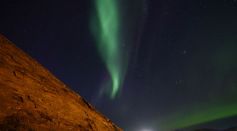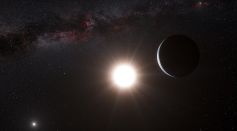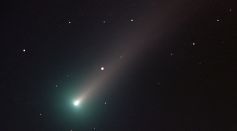Tags: Sun

Massive Solar Storm From a Star as Big as the Sun Could Be a Warning Sign for Earth, Study Says

Christmas Comet is Coming to Town: Here's How to Watch It Pass in the U.K. and Australia For the Last Time

Solar Flare Preparation: What You Should Do in Case It Hits Earth, Ignites a Geomagnetic Storm?
Solar Storm Warning: NASA Prepares For Swirling Debris That May Hit Earth This Week and Cause Mild Disturbance

Exoplanet Larger Than Giant Planet Jupiter Detected Intact Under Binary System; Parent Stars Bigger and Hotter Than the Sun
NASA’s TESS Captures Giant Active Comet Moving Farther Away From the Sun
Sun a 'Surprising Source' of Unexplained Water on Earth: What is Solar Wind Theory?

C/2021 A1 Leonard Comet Will Make an Exclusive Appearance in December Before Perihelion Passage in January 2022

ESA's Solar Orbiter Flyby Near Earth's Surface Will Be Visible Tonight, How to Watch
Solar Flare Warning: Geomagnetic Storm Could Reach Earth and Peak Sunday, Second Coronal Hole a Possibility
Powerful ‘Cannibal’ Solar Storm Incoming: Experts Warn Of 50,000 Mile-Long ‘Plasma’ From Sun’s Flare

Why is the Sky Blue, But Space is Black?
Partial Lunar Eclipse Will Be High in North American Skies: Here's When and Where It Will Be Visible
NASA’s Parker Solar Probe Bombarded by Plasma Explosions as It Gets Closer to the Sun; How’s the Spacecraft Doing?

Massive Solar Flare Continues to Hit Earth: Flights, GPS on Red Alert But Geomagnetic Storm Does Not Affect Airline Workers, Passengers
Geomagnetic Storm Triggered Auroras on Lower Latitudes; What Are the Effects of the Recent Solar Flare on Earth?
Northern Lights 2021: Watch Aurora Borealis in United States on Halloween Weekend Due to Solar Flare

Massive X1 Solar Flare Could Result In Impressive Aurora Lights This Weekend
Solar Cycle: Scientists Spotted a New Sunspot on Sun's Surface that is Facing Away From Earth

ESA BepiColombo Shares Stunning Audio From Its First Mercury Flyby [LISTEN]
Most Popular

Can the World Run Out of Water? Water Scarcity Science and Climate Impact Explained

Solar Maximum 2026: Inside the Sunspot Cycle and Solar Activity Forecast Astronomers Are Watching

Volcanic Warning Signs: How Magma Movement Reveals Eruption Prediction Clues for Geologists

How Tsunamis Form and Travel at Extreme Speeds: Seismic Waves and Coastal Hazards




